 The US Navy's nuclear powered midget submarine: NR-1
The US Navy's nuclear powered midget submarine: NR-1
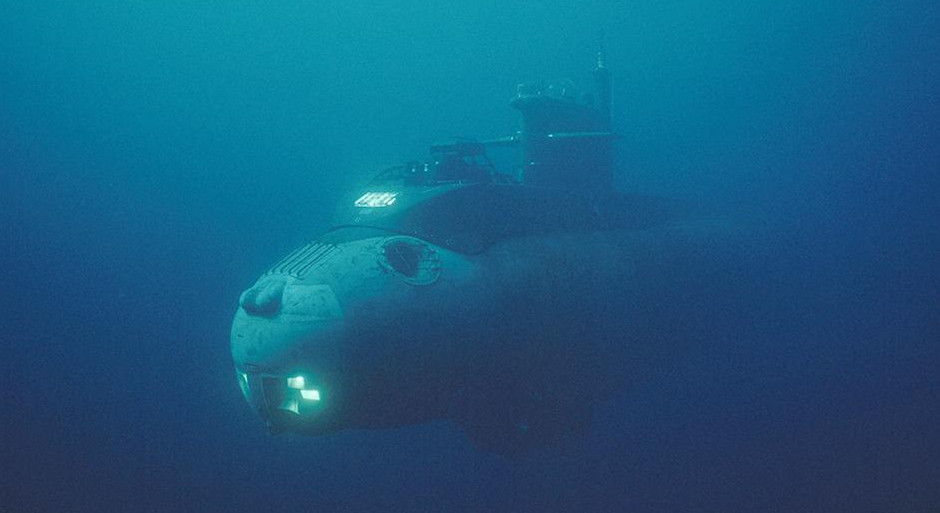
 At barely 40 meters (130ft) the NR-1 (Navy Reactors-1) was a midget submarine by US Navy standards. It was by far the smallest nuclear powered submarine in the world when she was launched on 25th January 1969. A special mission spy submarine, she was built under the guise of research, oceanography and later deep sea rescue in great secrecy in the same shed where the first nuclear submarine, USS Nautilus, had been.
At barely 40 meters (130ft) the NR-1 (Navy Reactors-1) was a midget submarine by US Navy standards. It was by far the smallest nuclear powered submarine in the world when she was launched on 25th January 1969. A special mission spy submarine, she was built under the guise of research, oceanography and later deep sea rescue in great secrecy in the same shed where the first nuclear submarine, USS Nautilus, had been.
Original artwork. CLICK for high-resolution image.

Background
Starting in the late 1960s the US Navy fielded a series of specially modified submarines capable of tapping Soviet submarine communications cables (SCC) which connected their remote naval bases with their headquarters. Unlike radio transmissions these physical wires were considered secure by the Soviets so a lot of the traffic on them was in the plain (i.e. not encrypted). So tapping these cables deep below the surface gave US Naval Intelligence a direct window into Soviet submarine operations, plans, readiness and procedures. This project, codenamed IVY BELLS was hugely successful. The first submarine modified for this ‘underwater engineering’ mission was the USS Halibut.
The ultimate book of Special Forces subs Covert Shores 2nd Edition is the ONLY world history of naval Special Forces, their missions and their specialist vehicles. SEALs, SBS, COMSUBIN, Sh-13, Spetsnaz, Kampfschwimmers, Commando Hubert, 4RR and many more.
Check it out on Amazon
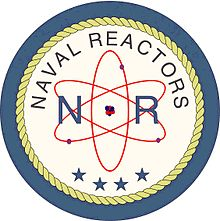 One man in the US Navy top brass viewed the USS Halibut project with deep suspicion however. As head of the Nuclear Reactors Branch Admiral Hyman G. Rickover was the boss as far as the nuclear submarine fleet was concerned, and as far as he was concerned also. As Father of the Nuclear Navy he’d overseen the rapid and hugely successful introduction of nuclear power and reigned over everything nuclear submarines did with an iron will. The only aspect he didn’t have much say in was intelligence gathering which was hidden behind need-to know barriers. This allowed Naval Intelligence and the CIA to keep him out. Missing out on the action, Rickover wanted his own special mission sub and set about building one from scratch. Working with the same US Navy scientist who was modifying Halibut, John P. Craven, Rickover set to work building his own private spy submarine; the NR-1. The ‘NR’ stood for ‘Navy Reactors’, avoiding a formal ‘USS’ commissioning. This was partly to discount it from being included in the ’41 for freedom’ nuclear submarine quota, but also underscored its direct relationship with Rickover who ran Navy Reactors branch.<
One man in the US Navy top brass viewed the USS Halibut project with deep suspicion however. As head of the Nuclear Reactors Branch Admiral Hyman G. Rickover was the boss as far as the nuclear submarine fleet was concerned, and as far as he was concerned also. As Father of the Nuclear Navy he’d overseen the rapid and hugely successful introduction of nuclear power and reigned over everything nuclear submarines did with an iron will. The only aspect he didn’t have much say in was intelligence gathering which was hidden behind need-to know barriers. This allowed Naval Intelligence and the CIA to keep him out. Missing out on the action, Rickover wanted his own special mission sub and set about building one from scratch. Working with the same US Navy scientist who was modifying Halibut, John P. Craven, Rickover set to work building his own private spy submarine; the NR-1. The ‘NR’ stood for ‘Navy Reactors’, avoiding a formal ‘USS’ commissioning. This was partly to discount it from being included in the ’41 for freedom’ nuclear submarine quota, but also underscored its direct relationship with Rickover who ran Navy Reactors branch.<

Admiral Rickover (left) and John P Craven (right).
From the start the NR-1 was to be very different from Halibut. Instead of using divers to carry out the work, NR-1 used hydraulic manipulator arms – where NR-1 was going it was much too deep for divers. She was incredibly deep diving, operating at up to 724 meters (2,375 ft) below the surface. This required special attention to the hull construction with much lower tolerances than normal submarines. The hull had to be perfectly circular in cross section (not even a millimeter out) to prevent it being crushed by the immense weight of water outside it. This attention to deep diving capabilities and the need to redirect millions of dollars to the program led to it being labeled as a rescue submarine. Deep Sea Rescue provided perfect cover because it was becoming an area of genuine concern and the public were generally accepting of the large amounts of taxpayers’ dollars being invested in new technologies that might help rescue men trapped deep underwater. NR-1 cost $30 million.
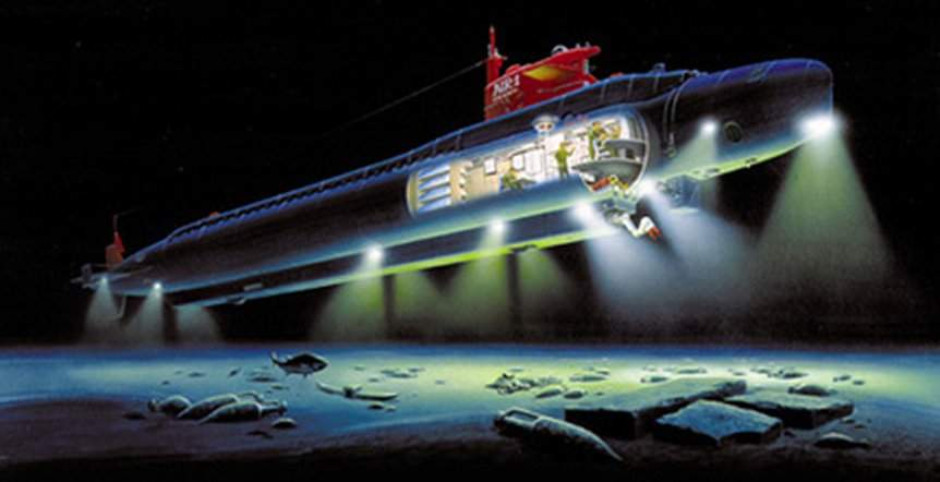
US Navy illustration of NR-1.
Few submariners had any illusions about the real chances of survival if their submarine went down but two high-profile nuclear submarine losses only heightened public awareness. NR1 was unsuited to rescuing anyone from the deep but she was painted bright colors and somehow convincingly passed off as search and rescue related. The project ran in parallel to the Halibut and competed for the same budget and talent pool. The two boats, although very different in every detail, where skinning the same cat. But the twain were never to meet because Halibut operated under Naval Intelligence command on the West Coast and NR1 under Rickover’s direction on the East Coast.
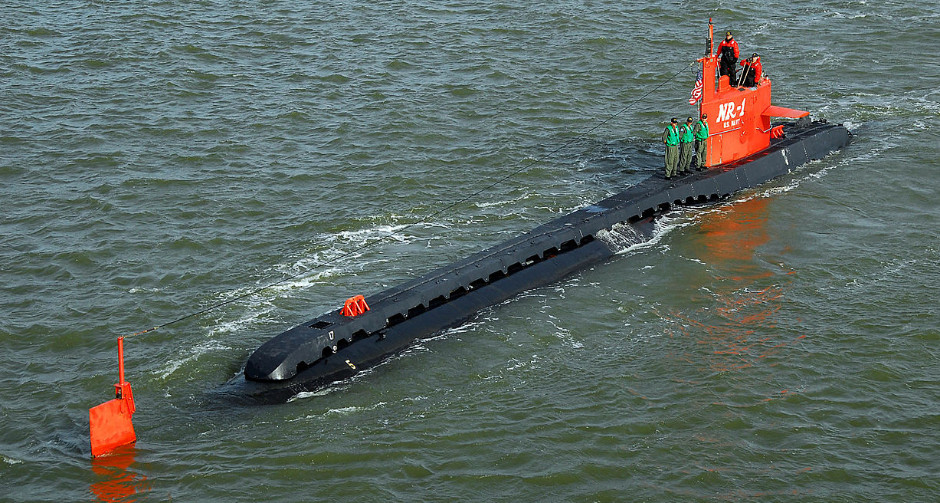
NR-1 was incredibly sophisticated and expensive, and at the same time cramped and cheaply fitted-out. There was a lot that was not glamorous about her. Basic fittings like the cooker were decidedly inadequate and the crew space was minimal. But on the other hand the nuclear powerplant was a wonder of miniaturization and simplification. When we think of nuclear reactors we think of massive power outputs, but NR-1’s reactor was tiny and barely comparable to a diesel engine. In order to save weight the lead shielding which normally surrounds a nuclear reactor was limited to the forward bulkhead which protected the crew. The crucial advantage of nuclear power was that it did not need air to run so the submarine could stay submerged for as long as the crew could. In the event that was about a month and the limiting factor was in fact the capacity of the toilet.

Photos of the control pannel of NR-1. From NAVSOURCE
Specification
Displacement: 365 tons surfaced, 393 tons submerged
Length: 40 meters (130 ft) (later slightly lengthened)
Beam: 5.3 meters (12 ft)
Speed: 4.5 knots surfaced, 3.5 knots submerged
Operating depth: 724 meters (2,375 ft)
Crew: 7 (2 officers, 3 enlisted and 2 scientists)
Endurance: Approximately 1 month
Armament: none
Payload: TBC

Capabilities
Aside from being Admiral Rickover’s personal midget submarine, her purpose was strictly cloak and dagger. She could dive down to an incredible depth and then drive along the ocean floor. That was over three times deeper than any fleet boat although still quite shallow compared to the open ocean which averages over 12,000ft (3,000m) deep. Her wheels, mounted in tandem along the keel were nothing more glamourous than Goodyear truck tires. But it worked and NR-1 could search the seafloor at zero distance using powerful floodlights to find the remains of Soviet missiles. A crewman laid on his belly in the bottom of the craft peering out through small portholes which gave a view of the sea floor. Once he found something of interest it could be retrieved by a hydraulic grabbing arm and placed in a retractable finds cage. The twelve crewmen were selected from the top graduates from the Navy’s elite nuclear power school where all submarine officers and engineers trained. Rickover insisted that all the crew must be graduates since this ensured that all of them were from his world. Despite the huge degree of secrecy, civilian engineers from defense contractors were on board to nurse the temperamental Mk-XV computer. This arrangement was not unusual and continues today on submarines.
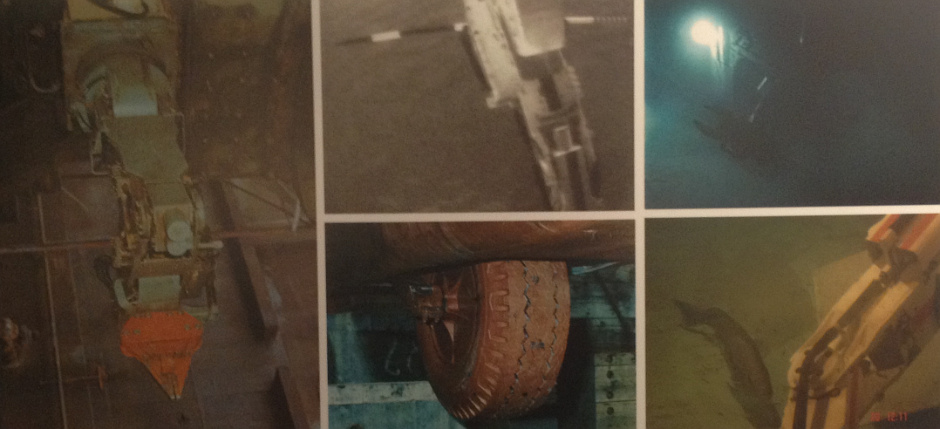
Hydraulic manipulators and wheels for driving along the sea floor.
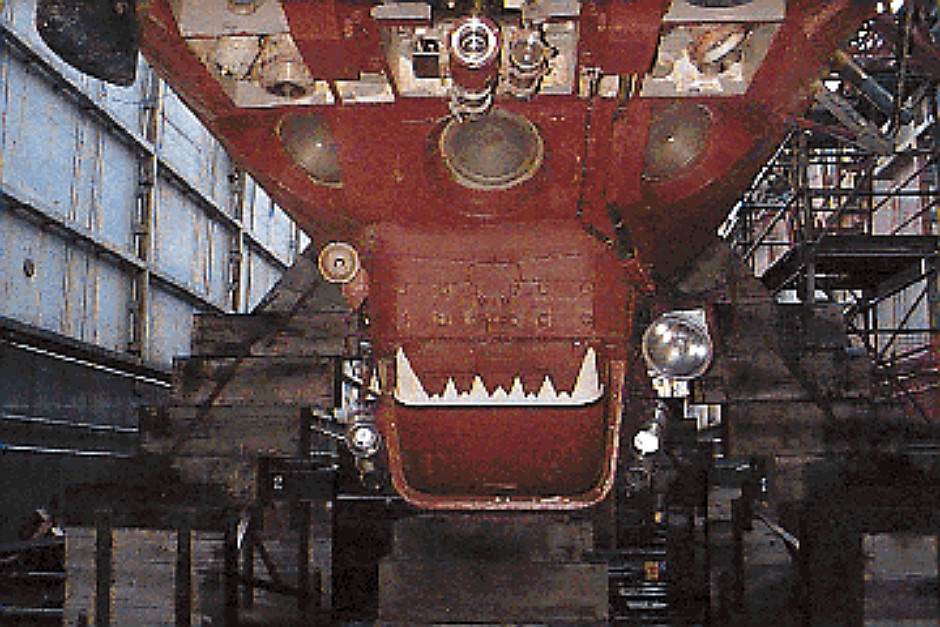
Teeth painted on the cover for the under-hull hydraulic manipulators.
Get The essential guide to World Submarines
This Covert Shores Recognition Guide Covers over 80 classes of submarines including all types currently in service with World Navies.Check it out on Amazon
The US Navy’s special missions boats pulled off some of the greatest intelligence coups in history. It was kept secret at the time but today there is some public awareness of their exploits. The exact ‘black sail’ missions of NR-1 remain a mystery however.

NR-1's distinctive orange/red paint scheme was part of her 'research' and 'rescue' cover story. During covert missions she may have been painted black.
What we do know is that in October 1976 NR-1 was used to locate and recovered a US Navy F-14 Tomcat fighter aircraft which had rolled off the deck of the carrier USS John F. Kennedy (CVN-76). The aircraft was in 600 meters ( 1,960 ft) of water. She was also involved in sea floor surveys in support of investigation into the Challenger Space Shuttle disaster in 1986.
NR-1 was retired in 2009 and parts of her are now on display at the Submarine Force Library and Museum in Groton. It's free, great museum, well worth a visit.
Related Articles

 USS Jimmy Carter (SSN-23)
USS Jimmy Carter (SSN-23)

 USS Halibut
USS Halibut

 USS Seawolf (SSN-575)
USS Seawolf (SSN-575)

 USS Parche spy sub par-excellence
USS Parche spy sub par-excellence

 Russian X-RAY Class spy sub
Russian X-RAY Class spy sub

 Russian Losharik spy sub
Russian Losharik spy sub

 Project 1910 UNIFORM Class deep diving spy sub
Project 1910 UNIFORM Class deep diving spy sub

 Soviet BS-64 Podmoskovye Special Mission (spy) Host Submarine
Soviet BS-64 Podmoskovye Special Mission (spy) Host Submarine

 Project 09852 Belgorod Special Mission submarine (spy sub)
Project 09852 Belgorod Special Mission submarine (spy sub)

 Russian unbuilt spy submarine MPS
Russian unbuilt spy submarine MPS


 Analysis of Swedish submarine incursion- Luleå 1983
Analysis of Swedish submarine incursion- Luleå 1983

 Yantar spy ship loitering over undersea cables
Yantar spy ship loitering over undersea cables
 Russia seeks submarine advantage in Arctic (SHELF system, GUGI special mission subs)
Russia seeks submarine advantage in Arctic (SHELF system, GUGI special mission subs)


